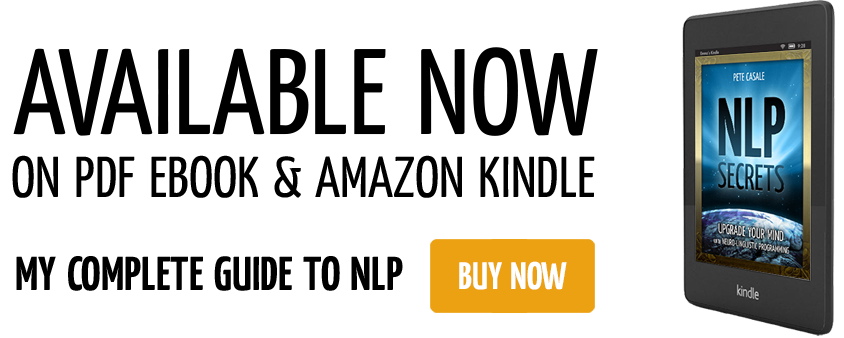 Anchoring is a useful NLP technique for inducing a certain frame of mind or emotion, such as happiness or relaxation. It usually involves a touch, gesture or word as an "anchor", like a bookmark for a desired emotion, and recall it again later using that same anchor.
Anchoring is a useful NLP technique for inducing a certain frame of mind or emotion, such as happiness or relaxation. It usually involves a touch, gesture or word as an "anchor", like a bookmark for a desired emotion, and recall it again later using that same anchor.
How to use anchoring
In this example, I need you to remember a time when you were very happy, such as when you won a competition, had your first kiss, or had some really good news. It can be anything you like, as long as it was definitely a very happy moment.
In your head, tell me the story of what happened leading up to that happy moment. Be vivid, and describe how it felt. Picture that moment in your head, and recall the feeling.
I want you to hold your left index and middle fingers in your right hand, and gently give your fingers two quick squeezes. As you do the second squeeze, make the picture of the happy moment larger, bringing it closer to you, and imagine the happy feeling multiply in strength.
Describe again how you are feeling. Describe what you were thinking at the time. As you do, squeeze your fingers twice. On that second finger squeeze, the happy feeling doubles, again. The clearer you can imagine the feeling, the better this technique will work. Repeat these steps until you have described then doubled the intensity of the feeling five times in a row.
That's the first part - laying the anchor. Later we can recall this anchor by using the exact same double-squeeze to recall a sense of happiness.
What is happening in our brains when we do this?
You are psychologically associating the neural signal of "two squeezes on my left fingers" with "happy". Therefore it stands to reason that the more times you lay the anchor (as above) and the more clarity you have in the feeling, the better this technique will work. We can combine this with plenty of other NLP techniques to make that feeling more clear and vivid, but for now we'll make do. This is known as conditioning.
The famous experiment by Russian scientist Ivan Pavlov describes him ringing a bell every time his dogs were fed. The dogs psychologically associated the experience of eating with the sound of the bell. Later on, the dogs would start salivating at the mere ringing of the bell. This is similar to what we are doing when we are using the NLP technique of anchoring.
Examples of when to use NLP anchoring
Anchoring is often used in seduction (soon to be covered in depth on NLP-secrets.com!) The most obvious example is when one party asks the other about a happy memory. When the seductee is "in the memory" ie they are smiling or laughing, the seductor uses either a distinct gesture or a light touch on the arm as an anchor. Whatever the anchor is, it mustn't be too noticible, otherwise it will appear unusual and the effect will fail.
Later on, the seductor can use that anchor to make the seductee feel the same kind of happiness as before, when the seductor is getting closer. The seductee will recall a happy feeling, but will now associate that happy feeling with being close to the seductor. It's a bit of a swindle, but it won't work if there is no attraction in the first place.
Personally, I use anchoring as a martial arts coach to improve my students' feeling of reward when they do well. After I spar (fight) with one of my students,we shake hands, every time. However, if my student has been pressed and puts up a good fight, I will add a light punch on the shoulder during the handshake. Sparring can be intense, and is often accompanied by adrenaline, and the associated endorphins (pleasurable feeling).
By using the punch on the arm anchor repeatedly, my students begin to associate it with the pleasure of post-adrenaline endophins. Using the same NLP idea behind Pavlov's dogs, I can eventually induce those same endorphins, just by doing that light punch. This is very useful when students are nervous/stressed before a tournament fight or grading.
Try it now, or before you go to bed tonight. Squeeze your fingers twice as you did before. It is more difficult to do on yourself, so perhaps try this technique with a willing partner. As with all NLP techniques, practice makes perfect!

NLP Technique: Swish
Swish, also known as Swish Pattern, is an NLP technique that is very useful for replacing an unfavourable emotion or behaviour with a more useful one. With a little bit of creativity, Swish can be used to do a lot of useful things, such as make going to the gym more fun or making foods that are good for you taste better.

NLP Seduction
NLP Seduction is an entire art on its own. If you have a thorough understanding of NLP, seduction is a straightforward process. Some suggest that using NLP for seduction is unethical, and that we shouldn't use "mind control" for seduction, but I strongly disagree. Everyone who attempts seduction is using some form of mind control whether they know it or not. Buying flowers, wearing cologne, even having dinner with someone has far deeper psychological connections than you may expect, and are forms of mind control.

Upgrade Your Mind with NLP Secrets. Boost Confidence. Beat Anxiety. Quit Addictions. Build Rapport.